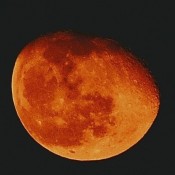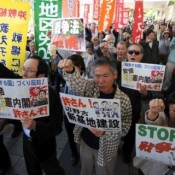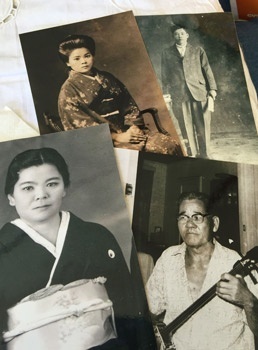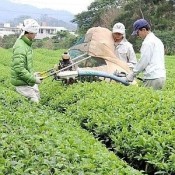Top News
March 23, 2016 Ryukyu Shimpo
Okinawa Governor Takeshi Onaga plans to visit Hawaii and the mainland of the United States of America and Canada in May, leading a caravan to promote the 6th World Uchinanchu Festival.
The festival will be held in October in Okinawa. The caravan will also visit Los Angeles, Washington D.C. and Vancouver.
Onaga revealed his plan when Ken Yamamoto, the new president of the Hawaii United Okinawa Association, paid a courtesy call on him on March 22.
The governor said, “I will visit Hawaii because I would like to convey my feeling of gratitude directly.”
According to the festival organizer, the caravan will leave Naha on May 9 and will return to Okinawa on May 19.
(English translation by T&CT, Hitomi Shinzato)
Go to Japanese

March 28, 2016 Ryukyu Shimpo
On the night of March 27, Ryukyu Shimpo received information from several readers that the moon was glowing red in the sky. It was four days after the full moon, and the slightly waning moon hung low in the sky, fantastically lighting up the night.
According to Takeshi Miyaji, director of the Ishigakijima Astronomical Observatory, when the moon is low in the sky, its light must pass through a thicker layer of atmosphere before reaching the earth, making it difficult for all light rays besides red to reach us. This can cause the moon to appear red. When the air is polluted, the moon is more likely to appear red, since pollution makes it more difficult for light to reach the earth.
(English translation by T&CT and Sandi Aritza)
Go to Japanese

March 29, 2016 Ryukyu Shimpo
In the early afternoon on March 29, about 250 participants of a gathering organized by the Okinawa Peace Movement Center called Abolish the War-Fighting Law! Don’t Let the Abe Administration Go Out of Control! raised their voices in opposition to the security legislation executed that same day.They called for repeal of the security legislation, saying that they will not tolerate militarism. Participants were widely varied in age, from those who personally experienced the Battle of Okinawa to children accompanied by their parents.
Chairman of the Okinawa Peace Movement Center Hiroji Yamashiro gave a speech before those gathered, among others. He declared that the security legislation is unconstitutional and that the Center will not allow expansion of the bases. His declarations were met with enthusiastic applause and whistling.
(English translation by T&CT and Erin Jones)
Go to Japanese

March 29, 2016 Ryukyu Shimpo
On March 28, the Ministry of Defense opened a new military base and radar station for Japan’s Ground Self-Defense Force on Yonaguni Island. About 160 personnel, who will be stationed at the base, arrived and an opening ceremony was held. With China’s maritime advances in mind, the government is taking measures to reinforce defense capabilities on the Nansei Islands. As part of this reinforcement, military personnel will monitor surrounding waters and airspace to track the activities of ships and aircrafts. This is the first time since Okinawa was returned to Japan that a new Self-Defense Force base has been opened in the prefecture.
Opinions among residents have been split regarding the new base. Last February, a referendum was held to allow the public to have a discussion on the pros and cons of the base. Although the majority is in support, friction still remains. On the opening day, there were around 15 residents carrying placards, protesting near the entrance of the base.
The Yonaguni coastal observation base consists of a radar unit, an observation unit, and a communication and intelligence unit. The new base located in the Kubura district of the island extends for about 25 hectares with an observation radar site and a barrack. A hectare of the base is located in Sonai District, where a radio tower was built.
In an interview, Daigo Shiomitsu, a Ground Self Defense Force lieutenant colonel responded, “There was a vacuum we needed to fill in the southwestern region. I believe it’s very significant that we have been stationed in Yonaguni to monitor the territory surrounding Japan, as well as to respond and deter, in all kinds of situations.”
(Translation by T&CT, Kaya Doi)
Go to Japanese
March 24, 2016 Ryukyu Shimpo
The Okinawa Prefectural Government and Okinawa Convention and Visitors Bureau concluded an investigative report on March 23 of personnel interacting with the tourist industry regarding their reception of foreign tourists during 2015. This is the first time the report has been conducted in two years, the last time being 2013. In 2015, 60.4 percent of business people, an 11.6 percentage point increase from two years prior, felt there was an increase in the number of foreign tourists to Okinawa. The percentage of personnel who try to draw in foreign customers has remained about the same at 37.6 percent. However, more personnel than before seem to be troubled by foreigners’ social etiquette.

Challenges of dealing with foreign tourists (percent of respondents)
Out of the advantages of dealing with foreign tourists, personnel most recognized the potential for expanding into new markets, at 48.1 percent of respondents to the questionnaire. The next most noted advantage is foreign tourists’ presence during the off-season for domestic tourism at 21 percent. Third most noticed is foreigners’ likelihood to binge shop and buy highly priced items at 19 percent.

Advantages of dealing with foreign tourists (percent of respondents)
The most recognized challenge of dealing with foreign tourists, continuing to be the most recognized since the 2013 report, is personnel’s inability to interact in a foreign language at 67.4 percent of respondents to the questionnaire. Even more respondents than in 2013 made note of the challenge of foreign tourists’ etiquette at 48.5 percent, an 8.9 percentage point increase. The issue of etiquette bore the most striking rise in concern among personnel of all the challenges on the questionnaire since 2013. The sort of recorded etiquette troubles personnel experienced are foreign tourists talking in a loud voice inside shops, drinking merchandise in front of the cash register at the time of purchase, and bad vehicle operation habits such as illegal parking.
This study has brought to attention important items for improving the situation such as providing foreign language training to current employees, hiring employees with foreign language ability, and drawing up manuals to assist in cases of medical emergency or general urgency when cross-cultural communication may prove difficult.
The 2015 report was compiled between January 25 and February 12 this year. Questionnaires were distributed to 2342 businesses including lodging facilities and restaurants, with 948 answered and collected at a 40.5 percent response rate.
(English translation by T&CT and Erin Jones)
Go to Japanese
March 24, 2016 Ryukyu Shimpo
A law to promote collecting the remains of war victims was passed in the Lower House plenary session on March 24. The ordinance sees the collection of the remains of victims in the war, including the Battle of Okinawa, as the “responsibility of the nation.” It will be put into effect on April 1.
The law had remained under deliberation after passing through the Lower House plenary session during the ordinary parliamentary session last year. This year’s Diet modified the collection period from the fiscal year of 2016 to 2024, and the law was passed in the plenary session of the House of Councilors this February.
With regard to collecting the remains, the Japanese government will design a master plan. The central government plans to discuss with the involved foreign governments and lay out the framework for expertizing the remains and analyzing articles left on the scene. The law stipulates that the government will newly designate a corporation in charge of gathering information on collecting the remains and preserving them.
(English translation by T&CT)
Go to Japanese

March 18, 2016 Ryukyu Shimpo
On March 18, the Ministry of Education, Culture, Sports, Science and Technology announced the screening results for high school textbooks to be used from the 2017 academic year. With regard to the description of “group suicide (forced mass suicide) of Okinawans” during the battle of Okinawa, five out of six Japanese history textbooks, from five companies, mentioned “group suicide.” No textbooks received screening comments. While the Shimizu Shoin annotated “group suicide” as “forced mass suicide,” other four textbooks referred only to “pressured” suicides. No textbook companies clearly mentioned the “compulsion” of “group suicides.”
The Shimizu Shoin text in a commentary on the Battle of Okinawa states that “There were tragic cases such as the murders of Okinawan civilians by the Japanese military and the enforcement of “group suicides.” Tokyo Shoseki noted, “This is called ‘Forced mass suicide’ by some experts.” Jikkyo Shupan used the description “group suicide or forced mass suicide.” Textbooks from the Yamakawa Shuppan and Daiichi Gakushusha used an expression with the word “pressured.”
Debating over the description of the “group suicide,” the screening process in 2006 commented, “It may lead to a misunderstanding of the situation of the Battle of Okinawa,” and deleted the description of enforcement by the Japanese military. In the 2011 screening, textbook companies avoided mentioning clearly the enforcement by the Japanese military. In the 2015 screening also, no screening comment was made.
Based on government guidelines for education, which had emphasized the education on territory, six geography textbooks from four companies, six Japanese history textbooks from five companies, ten textbooks of social science from six companies, and two political economy textbooks from one company mentioned the Senkaku Islands.
(English translation by T&CT and Megumi Chibana)
Go to Japanese
March 24, 2016 Ryukyu Shimpo
On March 23, Okinawan environmental conservation groups released a statement responding to the Ministry of the Environment’s proposal to designate the northern Yambaru area of Okinawa a national park. The groups urged the Ministry of the Environment to reconsider its current plan for the park. Under the current plan, only a small area is designated for special protection by stringent regulations limiting development. The environmental groups’ statement pointed to concerns that other areas of the park not protected by these regulations could be subject to deforestation, which could damage biodiversity in the Yambaru area over the long term, potentially leading to the extinction of certain species and populations in the area.
The environmental groups involved in preparing the statement held a press conference at the Okinawa Prefectural Office the day the statement was released. The two representatives speaking were lawyer and Yambaru DON-guris co-representative Jinen Kita, and NPO Okumagawa Basin Protection Fund representative Yoshiyasu Iha. The two represented ten organizations who are arguing that under the current plan, the area would not make it through the International Union for Conservation of Nature (IUCN) review process, making it impossible for Yambaru to be registered as a World Heritage Site under the natural criteria. The groups’ written statement was submitted to the Ministry of the Environment, the Okinawa prefectural government, and local government bodies in the three villages of Kunigami, Ogimi, and Higashi.
The statement criticized the fact that under the current plan, while 13,632 hectares (approximately 40 percent of the total 34,000 hectares that make up the Yambaru region) would be designated a national park, of that, only 790 hectares would be designated a special conservation area in which logging and removal of animal and plant life are strictly regulated.
Areas designated as national park land can fall under five different classifications. In addition to the “special conservation area” designation, there are three levels of “special area” designation with levels of regulation varying from least to most strict, as well as a “normal area” designation. All designations besides “special conservation area” allow logging with a permit.
Kita and Iha argued that many of the region’s most precious areas will not be designated special conservation areas under the current plan, the divisions of which they say are not based on scientific grounds. They say this amounts to the government approving of logging activities in the area.
(English translation by T&CT and Sandi Aritza)
Go to Japanese
March 17, 2016 Ryukyu Shimpo
Tuna fishermen in Okinawa experienced several incidents in which their long-line fishing nets were repeatedly cut by unknown causes in 2014. The US military’s ocean surveillance ship Impeccable was called into question. It became known that a Danish private maritime shipping company contracted by the US naval force offered to compensate a part of the cost caused by the damages to the fishing equipment on March 17. The prefectural fisheries cooperative association, who are representing the fishermen in a compensation claim, will discuss with the fishermen who sustained the damage in order to decide further plans.
The Danish shipping company offered to pay 80 per cent of the cost for the damaged equipment, approximately 3,620,000 yen. However, the exact cause of the damage has not been announced due to “confidential corporate information.” And compensation for fishing suspended due to the damage to the equipment has not been approved due to a lack of evidence.
The prefectural fisheries cooperative has demanded 4,520,000 yen for property-related recompense, such as fishing equipment, as well as 7,110,000 yen for compensation for suspended fishing. A total 11,640,000 yen has been demanded.
The chairman of the fisheries cooperative, Kameichi Uehara, commented, “There have been splits in opinions among the fishermen who received the damages. We would like to discuss with them by end of this month to decide what is to be done further.”
(English translation by T&CT and Sayaka Sakuma)
Go to Japanese

March 21, 2016 Ryukyu Shimpo
By Chikako Nago
Dorothy Shiroma Hoe is an 87-year old Okinawan Nisei (second-generation immigrant), born in Kahakuloa, Maui. She is the third daughter of Taro Shiroma from Kaneku, Nishihara City and Kamechia Ogusuku from Uchima, Nishihara City. Her father arrived in Hawaii in 1917 and her mother in 1921.
Dorothy’s heart swells with gratitude when she thinks about her parents. Neither of them spoke a word of English or had any kind of advanced education when they moved to Hawaii; they raised her in Uchinaguchi (Okinawan dialect). They worked hard on the plantations and later began growing vegetables in the fields. Then they started a greengrocer’s shop and opened a restaurant.

Dorothy Shiroma Hoe’s cherished photographs of her parents
“They sure put their heads together to support the family,” Dorothy says as she reflects on the long road that her parents had taken to get to where they were. As a child, Dorothy had to go around local neighborhoods trying to sell off leftover papayas from their greengrocer’s. “I was very embarrassed back then, but that experience taught me the importance of modesty,” she chuckles.
Dorothy’s father taught her traditional Okinawan performing arts, ranging from Ryukyu dance to drums. Her mother, Kamechia, was an extremely hardworking person who taught her to treat others with compassion.
While taking care of her old mother, Dorothy grew aware of the high demand of such elderly care. She switched jobs from being a substitute teacher to being a social worker.
At the same time, Dorothy served the Okinawan community in Hawaii for 36 years by broadcasting useful information in Japanese through the KZOO Japanese Radio Station. Although some people picked at her imperfect Japanese, Dorothy says contently, “I gave it my best.”
Dorothy also founded the “Kariyushi Show,” holding the position of chairperson for 24 years from 1989 to 2013. The Kariyushi Show offers a stage for senior citizens involved in performing arts to show the fruits of their practice to the public.
Dorothy has received awards from the state of Hawaii, Honolulu City County, and the Okinawan community for serving the community over the years.
Currently, she lives in Honolulu City with her Chinese-American husband, Ivan. Whenever Dorothy’s listeners contact her, she replies with the utmost care.
(Translation by T&CT, Kaya Doi)
G0 to Japanese

March 16, 2015 Ryukyu Shimpo
On March 15, the earliest tea picking in Japan started at Kanigawa-seicha tea production company’s tea plantation in Isagawa, Nago.
Workers in groups of three carefully picked new tea leaves shining under the morning sun. The harvest of the first tea leaves will start in Oku, Kunigami, Nakagawa, Kin, and Ogimi in Yambaru, the northern part of Okinawa island.
The tea leaves harvested are “Shizu-inzatsu 131”, a brand name of tea with a floral fragrance, which have been produced organically.
These tea leaves can be harvested throughout the year, but the leaves harvested in spring and autumn are considered to have a better taste.
(English translation by T&CT, Hitomi Shinzato)
Go to Japanese









 Webcam(Kokusai Street)
Webcam(Kokusai Street)


